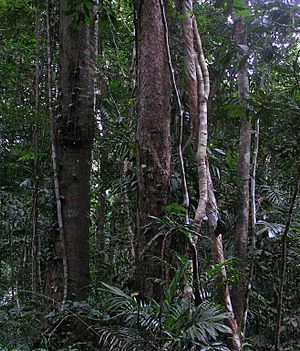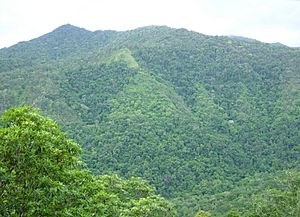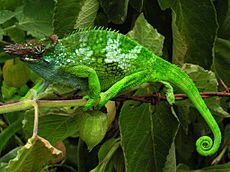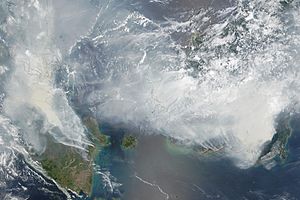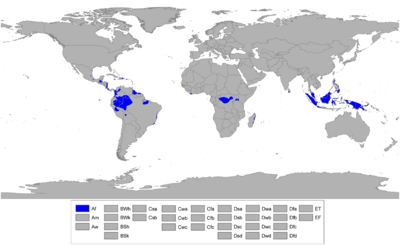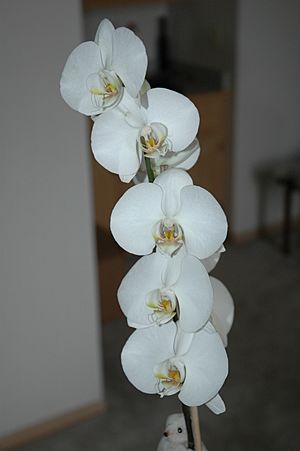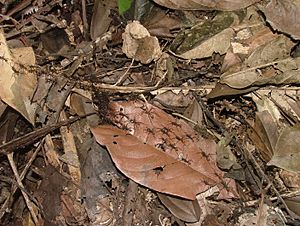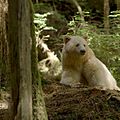Rainforest facts for kids
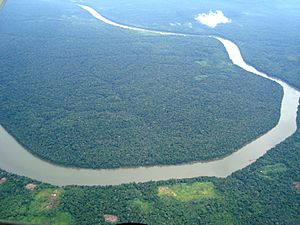
A rainforest is a special kind of forest that gets a lot of rain. Most famous rainforests are found in warm, wet areas called the tropics or subtropics. These areas are usually near the Equator. The biggest rainforest is the Amazon rainforest, mostly in Brazil.
Rainforests are super important because they have an amazing variety of life. Scientists believe that over half of all plant and animal species on Earth live in rainforests. Plus, more than a quarter of all medicines we use come from these forests! Even though they cover only about 6% of the Earth's land, they produce a lot of the oxygen we breathe.
Rainforests typically get between 50 to 250 inches (1.2-6.3 meters) of rain each year. They are warm all year, usually staying between 20 °C (68 °F) and 34 °C (94 °F). The air is also very humid, meaning it's wet and sticky, with 77% to 88% humidity.
Tropical rainforests are found in three main parts of the world:
- Parts of South and Central America, like the Amazon River basin and Costa Rica.
- Africa, especially the Congo River basin, and a small area in West Africa and eastern Madagascar.
- South Asia and Australasia, including the west coast of India, Assam, Southeast Asia, New Guinea, and Queensland, Australia.
There are also temperate rainforests, which are found in cooler areas. For example, in North America, these forests get over 140 cm (55 inches) of rain each year. Their average temperature is between 4 and 12 °C (39 and 54 °F). The weather in any rainforest is humid, feeling warm and wet, like a giant greenhouse.
Contents
What Makes Rainforests Special?
Rainforests have unique features that help them thrive:
- Most rainforest land is low, often below 700 meters (2,300 feet) above sea level.
- The climate is very rainy, warm, and stays pretty much the same all year.
- The plants are mostly flowering plants.
- They have very tall trees that form a thick roof.
- Many climbing plants (lianas) and air plants (epiphytes) grow there.
- Leaves are often large with "drip tips" to shed rain easily.
- Flowers and fruits are usually big.
- Insects do most of the pollinating.
- Most trees are evergreen, meaning they don't lose all their leaves at once.
- Rainforests are home to a huge variety of animals.
- There are tons of insects that eat plants, and plants have many ways to protect themselves from being eaten.
- Many mammals live in the trees (they are arboreal).
The Five Layers of a Rainforest
Tropical rainforests are like a tall apartment building, with different plants and animals living on different floors. There are usually five main layers:
- The emergent layer is the very top.
- Below that is the canopy layer, like a green roof.
- The understory is beneath the canopy, with smaller trees and vines.
- The shrub layer has bushes and smaller plants.
- The forest floor is the ground level.
Emergent Layer: The Tallest Trees
The emergent layer is the highest part of the rainforest. Here, the tallest trees poke out above the main forest roof. Eagles often perch here, looking for small monkeys or other prey. Colorful birds like parrots and toucans, along with butterflies, fly freely in this sunny layer.
Canopy Layer: The Green Roof
The canopy is like a giant green roof covering the entire forest. Trees in this layer grow tall and straight, reaching for the sun. They don't have many branches until they get very high, where they spread out like an umbrella. These trees grow so close together that very little sunlight reaches the layers below.
Many kinds of monkeys, birds, and insects live in the canopy. Some animals spend their whole lives here and never touch the ground! They find everything they need, like water from tree trunks or leaves, and food like fruits, leaves, insects, or other animals.
The tall canopy trees need to reach sunlight high up but also get nutrients from the thin soil. Their roots don't go deep because the soil isn't rich below the surface. Instead, their roots spread out wide and shallow. This helps them quickly absorb nutrients from decaying plants and animals that fall to the forest floor.
Understory Layer: The Shady Middle
The understory is usually a dark and humid place, right under the thick canopy. There's very little light and no breeze because the canopy blocks them. Plants here must be able to grow with very little sunlight. You'll find bushes, large green plants, and small trees in this layer. They often grow in open spots where a big tree has fallen. Other plants, like vines, climb up the big trees.
Shrub Layer: Home to Orchids
The shrub layer is mostly made up of bushes. It's a special place for many of the rainforest's orchids. Orchids here use water from the forest floor, nutrients from the understory, and some sunlight that filters through the canopy. Even though it's the smallest layer, it has over 84% of the rainforest's orchids! It's usually dark, with only small patches of sunlight. Despite the low light, it's very humid. Many insects, like scorpions, beetles, and tarantulas, live here. Some people group the shrub layer with the understory, making it a four-layer rainforest model instead of five.
Forest Floor: The Ground Level
The ground level is called the forest floor. Animals like Snakes, Tapirs, Jaguars, Tamanduas, and Gorillas live here. It's very dark on the rainforest floor because so little light gets through. Insects, giant centipedes, spiders, and ants are also very common. The forest floor is often quite open and easy to walk across because not many plants can grow in such low light.
Amazing Plants and Animals
Rainforests are home to incredible plants and animals.
Air Plants and Their Homes
One unique type of plant in the rainforest doesn't need soil. These are called epiphytes, or air plants. Air plants live on tree branches in the canopy or understory, with their roots hanging in the air. In the humid rainforest, they get water from the rain.
One famous air plant is the orchid. There are thousands of different kinds of orchids in the rainforest. Some air plants even collect water in small pools around their roots. These pools can become tiny homes for frogs and salamanders! Some rainforest tree frogs lay their eggs in these pools, so they never have to go down to the ground. Many rainforest plants are also used to make medicines for humans.
Insects: Tiny but Mighty
Millions of kinds of insects live in the rainforest because it never gets cold enough to kill them. You'll find bees, butterflies, termites, beetles, and many types of flies. Ants are everywhere! One interesting ant is the army ant. Army ants don't have permanent nests. They march in long lines every day to hunt other insects. At night, they link themselves together to form a living nest around their queen and baby ants.
Reptiles and Amphibians
Snakes live in the trees and on the forest floor. They eat frogs, eggs, birds, insects, and small animals. Some snakes, like the fer-de-lance in Latin America, are poisonous, but many are not. The anaconda of South America is a huge non-poisonous snake, one of the largest in the world. It kills its prey by wrapping around the animal and squeezing until it can't breathe.
Mammals of the Rainforest
Monkeys are very common in the rainforest. Most live high up in the canopy and understory. They have long arms to swing from branch to branch, and some even use their tails to hold onto trees while they eat. They are fast and agile, jumping easily between trees to find food like nuts, flowers, roots, and frogs. Their hoots and howls can be heard throughout the rainforest, even when you can't see them.
Many colorful birds also live in the rainforest canopy. On the forest floor, you might find animals like the tapir. A tapir looks like a large pig but is actually related to horses and rhinoceroses. They live in South American and Asian rainforests, eating leaves, twigs, and fruit.
Jaguars, leopards, and tigers are the biggest predators in rainforests. These big cats have beautiful fur coats. Sadly, their coats were once highly sought after for the fur trade. Today, many countries are working to protect these big cats, but some are still hunted illegally.
These are just a few examples of the incredible plants and animals in rainforests. About half of all the different species of plants and animals in the world live here. Many, especially insects, haven't even been given scientific names yet because they haven't been studied by scientists!
People of the Rainforest
Many groups of people have lived in rainforests for thousands of years. These forest dwellers usually live in one of two ways: as hunter-gatherers or as slash-and-burn farmers.
Hunter-Gatherers: Living Off the Land
Hunter-gatherers get their food by hunting animals and gathering plants, fruits, and nuts from the forest. Unlike in very cold or dry places, tools and water are always available. They don't need special clothes for protection from the weather. The forest even helps them hunt; many people use poisoned arrows, with the poison coming from forest plants, making hunting easier.
Slash-and-Burn Farmers: Growing Food
Most forest people are slash-and-burn farmers. They grow crops in small clearings while also hunting and gathering. This gives them food all year. They start by cutting down (slashing) trees and plants in an area. They let the dead plants dry, then burn them. The ash from the burned plants makes the soil fertile for a short time. This method is called slash-and-burn farming.
These small clearings can grow food for a few years. Then, the family or group moves on and clears a new field. The old field is left alone, and the forest quickly grows back. This type of farming doesn't harm the rainforest when only a few people do it. The small clearings become rainforest again without lasting damage. The land is used and then naturally recycled. However, this is changing today because too many people are burning the forests, making them shrink.
Rainforests in Danger
Rainforests are facing serious problems. They are being cut down too quickly. Every year, an area about the size of West Virginia is destroyed. This is a problem for everyone on Earth.
For many years, rainforests were so vast and dense that few people lived there. But today, that's changing. Millions of poor, often hungry, people live near the world's rainforests. They are looking for a better life and believe they can find it in the forests.
Settlers can now get into rainforests because modern machines have built roads deep into the jungle. These roads are often built by businesses wanting to cut down trees or dig up minerals. Governments also build roads for trade and to allow people to settle. Thousands of poor people come into the forest on these roads, taking land to grow food. They burn down trees and plants to create fields, then plant crops to eat and sell. When many farmers do this, there isn't enough forest left to grow back.
The new farms can only grow crops for a few years because the soil is poor. Farmers then sell the land to cattle ranchers or simply leave to clear new land. The soil is so poor that it won't even grow grass for cattle for more than a few more years. After that, the ground becomes hard and can only grow a few weeds. The rainforest is destroyed, and the land becomes unusable.
If this continues, the forests will be gone, and the farmers will have nowhere to go. Then, those people will starve because there will be no land left to grow food. Forcing them to stop cutting down the forest won't help, as they would just starve sooner. New ways are needed for these people to live on rainforest land without destroying it.
Also, no one knows how destroying rainforests will change the Earth. We know that less rain will fall once the trees are gone. This might cause some rivers, which supply water to cities, to dry up part of the year. Burning trees also releases carbon into the air. Carbon traps heat from the sun. Experts are debating if burning so many trees will change the air and make the Earth's climate warmer. It might be happening.
Rainforests are also the source of many things useful to humans. As many as one out of every four drugs bought in stores were first found in rainforests. Coffee, chocolate, bananas, corn, tea, sweet potatoes, Brazil nuts, rubber, and tapioca all came from the rainforest. Very valuable wood like mahogany, teak, and balsa wood also comes from there. These trees cannot grow without the thick, wet, warm rainforest environment. So, losing rainforests would harm many people beyond those who live there.
Tropical rainforests are located in a band around the Equator (0 degrees latitude), mostly between the Tropic of Cancer (23.5° N latitude) and the Tropic of Capricorn (23.5° S latitude). This 3,000-mile (4,800 km) wide band is called the "tropics."
A Simple Rainforest Food Chain
Producer: Kapok Tree → Primary Consumer: Fruit Bat →Secondary Consumer: Boa Constrictor → Tertiary Consumer:Harpy Eagle → Decomposers: Fungi, Termites, and Bacteria.
Related Pages
Images for kids
-
A Kermode bear from the Great Bear Rainforest, Canada.
-
A Bengal tiger in Mudumalai National Park, India.
-
A jaguar in the Amazon Rainforest, South America.
-
Yellow anacondas reside in the Amazon basin.
-
Lion-tailed macaque in Silent Valley National Park, India.
-
A Macaw in the Amazon rainforest.
See also
 In Spanish: Bosque húmedo para niños
In Spanish: Bosque húmedo para niños


